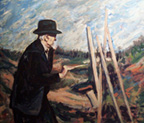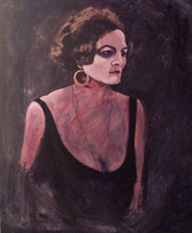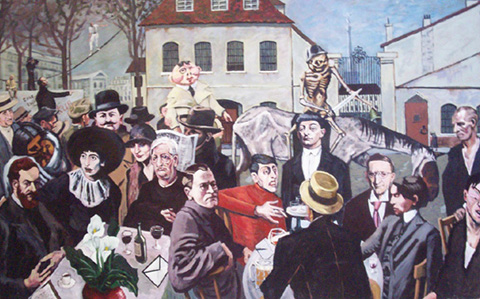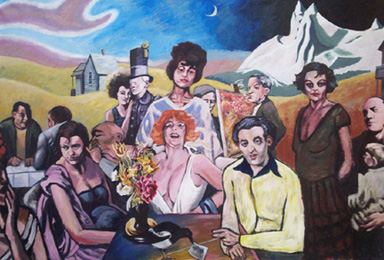The French fall classic 2006 .. and Central Europe in Toronto Art
Oct 23rd, 2006 | By Randall White | Category: Entertainment Probably very few citizens of the USA today would want to call Detroit Tigers vs. St. Louis Cardinals the French World Series of 2006. But this does make some sense for Canadians, francophones and anglophones alike, who know their own history. Detroit was founded in 1701 by Antoine de la Mothe, Sieur de Cadillac, and St. Louis by Pierre Laclede and Auguste Chouteau in 1764. Both places began as outposts of the old “French and Indian” fur trade (which would also found Canada itself). Meanwhile, back in the city of the Blue Jays who finished second in the American League East this year, another annual fall classic has been exploring the legacies of another part of Europe in Toronto art. Many of us these days, it seems, have one eye on the future and one eye on the past.
Probably very few citizens of the USA today would want to call Detroit Tigers vs. St. Louis Cardinals the French World Series of 2006. But this does make some sense for Canadians, francophones and anglophones alike, who know their own history. Detroit was founded in 1701 by Antoine de la Mothe, Sieur de Cadillac, and St. Louis by Pierre Laclede and Auguste Chouteau in 1764. Both places began as outposts of the old “French and Indian” fur trade (which would also found Canada itself). Meanwhile, back in the city of the Blue Jays who finished second in the American League East this year, another annual fall classic has been exploring the legacies of another part of Europe in Toronto art. Many of us these days, it seems, have one eye on the future and one eye on the past.
From fur trade to world series …
 Like the legendary Pontiac, the War Chief of the Ottawa who was reigning terror on the western Great Lakes at about the same time that Laclede and Chouteau were founding St. Louis, Antoine de la Mothe, Sieur de Cadillac is almost certainly best known today as the namesake of a General Motors automobile brand.
Like the legendary Pontiac, the War Chief of the Ottawa who was reigning terror on the western Great Lakes at about the same time that Laclede and Chouteau were founding St. Louis, Antoine de la Mothe, Sieur de Cadillac is almost certainly best known today as the namesake of a General Motors automobile brand.
Automobiles in our own new global economic era aside, some of the French fur traders and gentlemen adventurers who followed their native North American allies into the Great Lakes interior long ago now went north and west, on the vast inland waterways that first spread Canada from sea to sea … and sea. Others went south and west, down the Mississippi Valley to the Gulf of Mexico – and into the “Great West” of modern America, first known as Louisiana.
Cadillac, after he founded Detroit (which some would say still properly belongs in Canada, along with most of the other northern US border states), went on to become a governor of “the French Province of Louisiana” (which Thomas Jefferson would eventually purchase from Napoleon for the new USA). Almost two generations later Laclede and Chouteau came from New Orleans to found St. Louis, “some 18 miles south of the junction of the Missouri and Mississippi Rivers.” Though located in what was considered by Europeans to be Spanish territory at the exact moment of its founding, the city was “named for King Louis IX of France” (12141270 and “the only French king ever to be made a saint.”)
In any event, back in 2006 John Donovan at Sports Illustrated has said: “C’mon, now. Detroit? St. Louis? This was set up to be a World Series only a Midwestern mother could love. The ratings for this promise to be as abysmal as the weather.” Even so, “two games into this not-yet Fall Classic between the Tigers and Cardinals, we have the makings of a real, live, maybe even interesting World Series … Which is, as we should have figured, just the opposite of what we all figured.” So stay tuned. Up here north of the Great Lakes, we are still betting on Detroit.
Michael J. Seward’s fall classic at the Annex Art Centre in Toronto …
Meanwhile, some of us have also been fortunate enough to catch the annual fall viewing of the anglophone Canadian artist with a francophone wife, Michael J. Seward, at the Annex Art Centre in Toronto.
All his latest paintings are fascinating and engaging (including the one of French artist Paul Czanne, which appears at the top of my piece here). As he explained in an interview, however, the underlying theme of this year’s work is Central Europe in the era of the two world wars – a place and a state of mind that had much influence on the half-Midwestern city of Toronto in the later 20th century. (Which is also where the now 61-year-old Michael J. Seward grew up, with a father from Newfoundland, a mother from Alberta, and an older brother who is now a geology professor in Zurich, Switzerland.)
The centrepiece of this theme is a striking painting called “The Outdoor Caf.” The artist himself has provided some interpretive notes, which I reproduce in part:
 “Here are a lot of people – Europeans for the most part – sitting perhaps a little self-consciously at an outdoor caf while behind them Death in his war helmet brandishing his sword rides by on his tired old nag (after Breughel). Strangely, the people don’t seem to notice; although there seems to be an assortment of soldiers and workers who do.
“Here are a lot of people – Europeans for the most part – sitting perhaps a little self-consciously at an outdoor caf while behind them Death in his war helmet brandishing his sword rides by on his tired old nag (after Breughel). Strangely, the people don’t seem to notice; although there seems to be an assortment of soldiers and workers who do.
“Who are these people? From left to right: In the straw hat on the far left is Apollinaire, the Polish/Italian promoter of the avant-garde, poet, art critic, and trickster. In the foreground is Hugo Trondle and an unidentifiable woman in a big hat … At the back with a cigarette dangling is Marinetti, self-imposed leader of the Futurist movement, a poet who glorified war as a means of cleansing the world of stodgy cultural institutions and no doubt of their personnel …
“The pretty face is Kiki, a country girl who arrived in Paris and soon became a model for the artists of the Montparnasse … Sitting in front of her is de Chirico … the Italian “surrealist”who along with Carra started the Piturra Metafiscia movement. These two had an influence on painters in Germany who were fed up with Expressionist angst and wanted a New Objectivity in their work. The image here of de Chirico is based on a self-portrait he painted in 1957 …
“Behind him stands a man reading a newspaper … At the next table we have Rudolf Levy, a German/Jewish painter who was in Paris from Munich. Then there’s Sylvia von Harden, a German journalist … Alfred Doblin is sitting looking rather benignly out at us. He was the author of many books. Berlin Alexanderplatz was one of them … Standing between Harden and Doblin is Moishe Kisling, a Polish/Jewish painter newly arrived in Paris, down and out (like George Orwell around the same time) … Beside Doblin is Pascin the Bulgarian Jewish painter who had come to Paris to join the artistic fray. Here he looks like he could be regretting his move …
“The man standing observing these afternoon drinkers is based on a photo by August Sander of an unemployed WWI veteran. On the left but in the background, the gentleman with his hand raised in polemical fashion is based on a snapshot of 1918, or thereabouts, of Karl Liebknecht, friend and co-revolutionary of Rosa Luxemburg … The tight-rope walker is there to remind us of the precarious times these people were navigating through. Two men are carrying a mannequin of a puff-faced buffoon (after George Grosz, who made his own papier-mache model of the The Conservative Man).”
Just two more items of business remain in my own piece here. First, the Michael J. Seward painting only somewhat inappropriately reproduced at the top of the section on “From fur trade to world series” above is called “The Performer.’ It depicts “Anita Berber … a nude dancer during the Weimar Republic in Berlin … she lived an ecstatic life of dance and substance abuse dying at the age of 29.” (And there have always of course been strong German undercurrents as well in the North American Midwest, just to keep the theme of Detroit and St. Lewis intact.)
 Finally, the painting here with which my own piece ends is called “The Group.” Its North American-European background borrows from Thomas Hart Benton and Max Ernst. It includes the legendary German singer Lotte Lenya, at the table on the left (also the partner of songwriter Kurt Weill, and someone whom even Bobby Darrin’s 1960s recorded version of “Mack the Knife” mentions by name).
Finally, the painting here with which my own piece ends is called “The Group.” Its North American-European background borrows from Thomas Hart Benton and Max Ernst. It includes the legendary German singer Lotte Lenya, at the table on the left (also the partner of songwriter Kurt Weill, and someone whom even Bobby Darrin’s 1960s recorded version of “Mack the Knife” mentions by name).
On the other side of the table, on the right, the “young man holding the magpie by a string is Gershon Iskowitz, a Polish/Jewish survivor of the Holocaust who made it to Canada and became a painter of beautiful idiosyncratic and enigmatic work largely based on Canada’s northern landscape.”
If you want more information about Michael J. Seward’s paintings, contact the Annex Art Centre in Toronto at info@annexartcentre.com. To wrap everything up, we can all think about just how much more attractive the world might be if Detroit vs. St. Louis was called the French World Series, instead of mindless Midwestern boredom for the bi-coastal USA today. That seems to me at least yet another interesting thing that Michael J. Seward’s angular Central Europeans from the earlier part of the 20th century are so audaciously trying to say.
